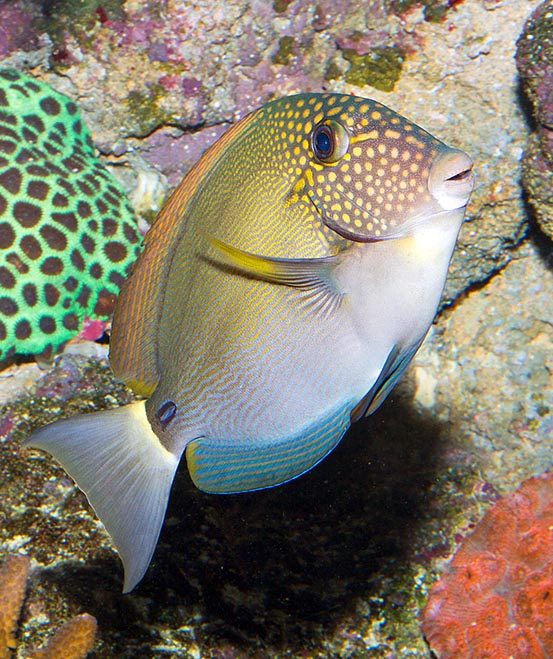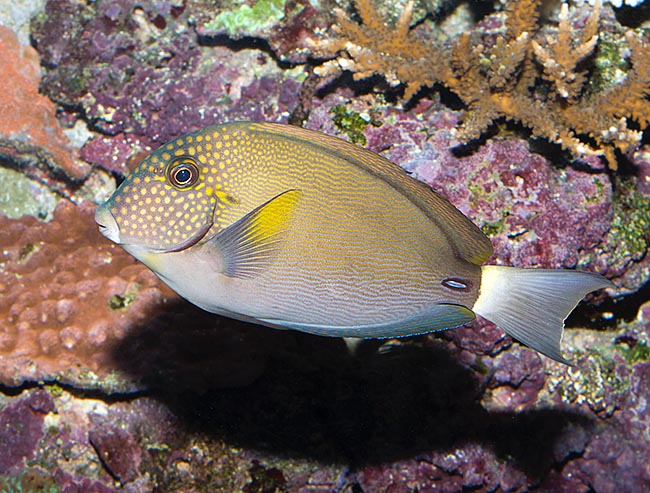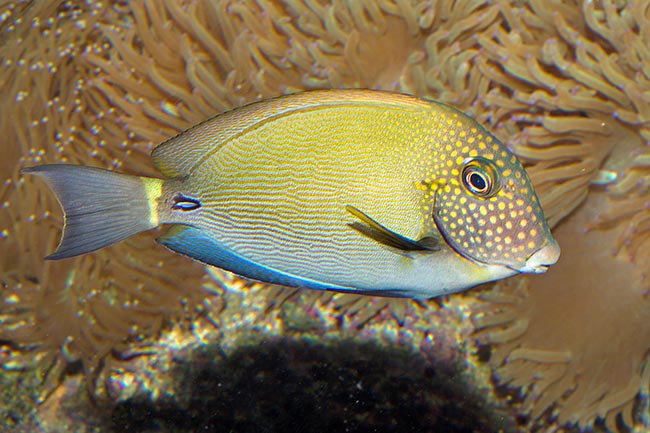Family : Acanthuridae

Text © Giuseppe Mazza

English translation by Mario Beltramini

Acanthurus maculiceps usually lives in shallow waters © Giuseppe Mazza
The White-freckled surgeonfish (Acanthurus maculiceps Ahl, 1923) belongs to the class of Actinopterygii, the ray-finned fishes, to the order of Perciformes and to the family of Acanthuridae.
The etymology of the genus Acanthurus comes from the Greek “akantha” = spine and “ura” = tail, due to the spine, sharp as a razor, these animals have on both sides of the caudal peduncle.
The name of the species maculiceps comes from the Latin “macŭla” = spot, and from the suffix “ceps”, form derived from the Latin “caput” = head, t is, in fact, a fish having spots on the head.
Zoogeography
It is present in the tropical waters of the eastern Indian Ocean and in those of the western Pacific Ocean.
Just to give an idea of its distribution, we find it at the Maldives, the Andaman Islands, the Cocos Islands, at Christmas Island, in Indonesia, Australia, New Guinea, Micronesia, Philippines, Taiwan and, south of Japan, in the Ryukyu Islands. Eastwards, it has reached Samoa.
Ecology-Habitat
Excellent swimmer, it lives also in the troubled waters on the outer side of the reefs not under the 30 m of depth, usually in the zone between the 3 and 15 m, where the seaweeds it eats do abound.
Morpho-physiology
It can be 40 cm long. The body is flat, with the contour of the head neatly convex in the adults, more or less oval, with only one great dorsal fin counting 9 spiny rays and 24-26 soft ones. The anal fin is symmetrical but shorter, with 3 spines and 22-24 unarmed rays. The pectoral ones, with 16-17 rays, are more or less triangular and slightly pointed at the apex, and the ventral ones have one spine and 5 unarmed rays.

Unique characteristics are the spots on the head and the caudal peduncle white band © Giuseppe Mazza
The caudal, truncate in the juveniles, becomes later on lunate with filamentous lobes in the oldest specimens. On the sides, it is finely horizontally grooved by irregular yellow and brown stripes which interest also the dorsal and anal fins, even if the zone under the chin is pale, without drawings, and in the lower part of the body the brown often turns bluish.
The head, as the name of the species indicates, is conspicuously yellow spotted and on the caudal peduncle catches the eye a white vertical band after the characteristic scalpel of the surgeonfishes.
It is highlighted, on both sides, by a dark brown oval which emphasizes the more or less blue coloured housing of the sharp and venomous spine. This is a reminder for the aggressors who have experienced it.
Another typical mark is the terminal yellow part of the pectoral fins, but we have to add that, depending on the circumstances, the livery may incredibly change all over the body turning from pale yellow to dark brown in a few seconds.
Ethology-Reproductive Biology

It may change colour getting various shades of yellow up to dark brown © Giuseppe Mazza
The White-freckled surgeonfish lives solitary or in small schools, nourishing of filamentous seaweeds and of the pellicle of microscopic algae and debris covering the sea-beds, but grazes also more consistent benthic seaweeds. It is, in short, the sweeper of the reefs.
During the reproductive period the males often get showy colours and the fecundated eggs are abandoned to the currents. The juveniles have a sand white coloured livery and only by around the 20 cm of length they gradually get the colours and the drawings of the adults.
The populations may double in 1,4-4,4 years, but the fishing vulnerability index of the species is not to be ignored as it is already of 39 on a scale of 100.
Synonyms
Hepatus maculiceps Ahl, 1923.
→ For general information about fishes please click here.
